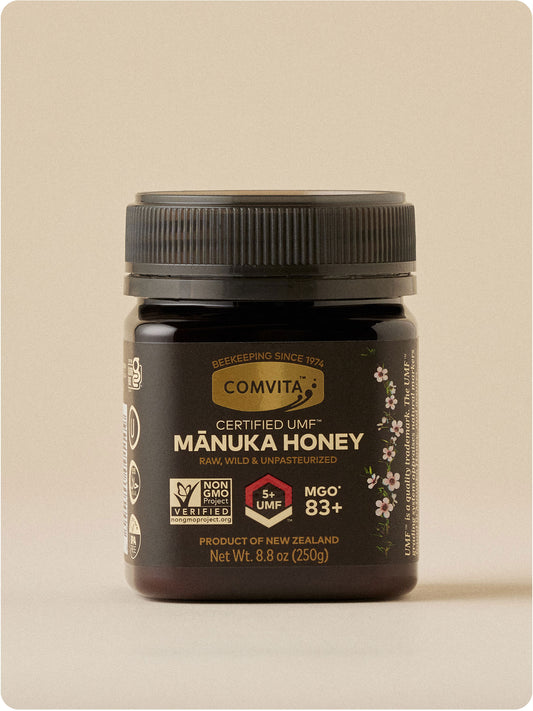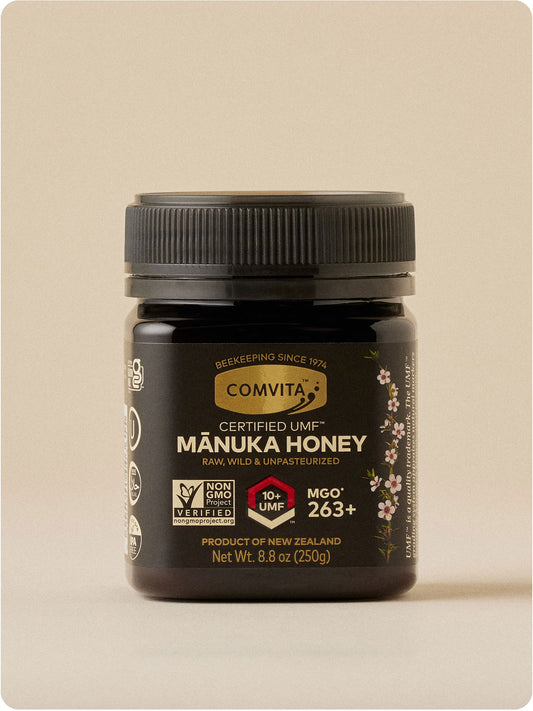
How to Identify Authentic Manuka Honey
Want to be sure you’re getting the highest quality Manuka Honey on the market? Here’s what to look for when shopping for premium, authentic Manuka Honey.
1) Be sure the Manuka Honey has a UMF™ Certification logo on the jar.

When shopping for Manuka Honey, be sure to keep your eyes peeled for the UMF™ logo on the jar, as you see highlighted in the image above. The UMF™ Certification (Unique Manuka Factor) is the only independently tested rating system for genuine Manuka Honey, with every batch of our Manuka verified by the Unique Mānuka Factor Honey Association (UMFHA). According to the UMFHA,
“UMF™ is the ONLY comprehensive, scientifically tested Manuka quality mark that exceeds government standards, certifying the best quality honey. It guarantees the extra mile has been taken to ensure what you buy is truly what it says it is.”
The UMF™ rating number verifies the presence of unique signature compounds characteristic of genuine Manuka Honey. These key compounds are Leptosperin, DHA and Methylglyoxal (MGO). As it states on the UMFHA website,
“Every UMF™ certified Manuka batch undergoes our Four Factor Quality Assurance Testing (using independent laboratories) confirming authenticity, purity, quality and shelf life. MGO’s potency is just one measure, alongside the leptosperin marker that identifies true Manuka (we’re keepers of this IP). DHA identification ensures long shelf-life potency. HMF testing checks the product is not old and hasn’t been overheated, confirming the Manuka’s unique compounds remain intact.”
The higher the UMF™ rating on your jar, the higher the bioactive compounds, notably the MGO, the key natural compound that is known for giving Manuka its healing benefits. For example, a UMF™ 5+ jar of Manuka has a minimum of MGO 83+, versus the next level up, the UMF™ 10+ jar, which has a minimum of MGO 263+.
Pro tip: as you increase the UMF™ level, not only do the therapeutic abilities of the honey increase, the rich golden color and luxurious flavor and texture intensify as well.
2) Manuka Honey must be harvested from New Zealand
Authentic Manuka Honey must come from New Zealand. Just like real champagne only comes from the Champagne province in France, and everything else outside the region is considered sparkling wine, genuine Manuka must come from New Zealand, where the native Manuka Tree grows. New Zealand’s Ministry for Primary Industries (MPI) set new standards for what can be exported to the United States as “Manuka Honey” after August 2018. Comvita Manuka Honey is sustainably harvested from the pristine forests of New Zealand.
3) The nectar must come ONLY from the Manuka flower.
All UMF™ Certified Manuka Honey is monofloral honey, meaning sourced from one flower, the Manuka flower. This means each batch tests high for the 3 aforementioned key bioactive properties derived from natural compounds found in the nectar of the New Zealand Manuka tree (Leptospermum scoparium). However, according to Comvita’s Chief Science Officer, Dr. Jackie Evans, Ph.D.,
“...without the bees collecting this nectar and making it into Manuka Honey we would not be able to benefit from these properties. The bees also add enzymes and other substances during the honey making process that enhances some of the bioactive properties of the final honey. The Manuka tree also needs bees and other insects to pollinate its flowers. So it’s truly a symbiotic relationship, without both the bees and the trees we would not have the special qualities of Manuka Honey.”
During a 2-6 week period, peaking in mid-December (the start of Summer down in New Zealand), Manuka is in bloom. Individual flowers may only be open for 5 days - making a very short window for bees to collect nectar from the flower. During peak, Comvita works in harmony with the bees to be sure their hives are strategically placed nearest the Manuka blooms during this time. We carefully choose remote sites, many deep in the forests of New Zealand hillsides, where we place our hives to ensure that they are far from urban areas so the bees can collect only pure Manuka nectar in a safe clean environment to ensure the quality and potency of our Manuka Honey. Given the extremely short flowering season, as well as other factors like wind and rain that could disrupt the bees, it takes immense skill, planning, and resources to harvest Manuka Honey, which is why we never take a single, precious drop for granted.
Learn more ,a href="https://www.comvita.com/blog/10-fascinating-facts-about-manuka">fascinating facts about the Manuka flower here.
4) Research Your Source
When you’re shopping for authentic Manuka Honey, you want to make sure you’re buying a single-ingredient Manuka, with no added fillers, that is ethically harvested, with quality assurance. As the pioneer and trusted global leader in Manuka Honey, Comvita is committed to bringing you the most premium Manuka, with the highest certifications and transparency. With nearly 50 years of beekeeping craftsmanship and a world-class, in-house lab, Comvita’s rigorous standards are unrivaled:
“At Comvita we control the supply chain from hive to home, which means we can guarantee the highest quality Manuka Honey. Working together in harmony with nature and science is what we do best. We have our own Queen Breeding program, breeding elite queens that ensure our hives are healthy and strong. Our own beekeepers tend to our own hives and we carefully nurture the health and welfare of our bees year round so they are in tip top condition and ready to collect honey in the short period of time when the Manuka flowers bloom which is only 2-6 weeks per year. We carefully select and breed Manuka trees that are vigorous, disease free and have high levels of DHA in their nectar needed to make high UMF™ honey.” - Dr. Jackie Evans, phD, Comvita Chief Science Officer
We test every single batch of our Manuka Honey for quality, purity, and potency, with transparency and transparency from hive to shelf, so you can have peace of mind with every golden spoonful.






